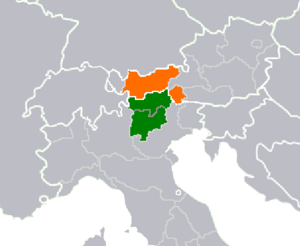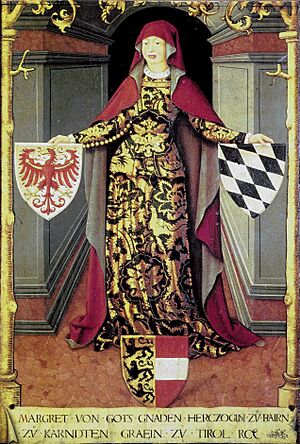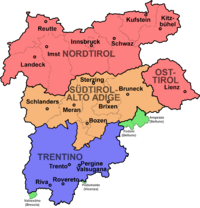History of Tyrol facts for kids
The history of Tyrol is about a special area in the middle of the Alps in Central Europe. People first settled here around 12,000 BC, right after the last Ice Age ended. Farmers and herders started living in one place around 5000 BC. Many valleys became home to communities during the early Bronze Age, from 1800 to 1300 BC. Two important cultures grew from these early settlements: the Laugen-Melaun culture in the Bronze Age and the Fritzens-Sanzeno culture in the Iron Age.
The Romans conquered this region in 15 BC. The northern and eastern parts became Roman provinces called Raetia and Noricum. This Roman influence greatly shaped the local culture and languages, leading to the Rhaeto-Romance languages. Later, in the 5th and 6th centuries, Tyrol became part of the Ostrogothic Kingdom. By 553, southern Tyrol joined the Lombards' kingdom in Italy. Northern Tyrol came under the influence of the Bavarii, and western Tyrol became part of Alamannia. These three areas met near what is now Bolzano.
In 774, Charlemagne conquered the Lombards. This made Tyrol an important link to Italy. In the 11th century, the Emperors of the Holy Roman Empire gave control of some areas to the Bishops of Trento and Brixen. This meant the Emperors had a strong hold over the region.
Over the next centuries, the counts living in Tirol Castle near Merano expanded their land. By 1295, the "county and reign of Tyrol" was firmly established. When the Meinhardiner family, who ruled Tyrol, ended in 1369, Tyrol was given to the House of Habsburg. The Habsburgs ruled for over 500 years, except for a short time during the Napoleonic Wars when the Bavarians took control.
After World War I, the Treaty of Saint-Germain-en-Laye in 1919 gave the southern part of Tyrol to Italy. This included South Tyrol, which had many German-speaking people. The northern part of Tyrol stayed with Austria. Today, the historical region of Tyrol includes the Austrian state of Tyrol and the Italian provinces of South Tyrol and Trentino. The borders of the Tyrol–South Tyrol–Trentino Euroregion are similar to the old Habsburg County of Tyrol.
Contents
Early Times: Prehistory
Archaeological finds show that people settled in the middle Alpine region, later called Tyrol, after the glaciers melted around 12,000 BC. This was when plants and animals returned. Tools found in the Seiser Alm area are from the Upper Paleolithic era. In the valleys near Bolzano and Brixen, resting places of Mesolithic hunters were found. Stone tools there are about 10,000 years old.
The discovery of Ötzi the Iceman in 1991 proved that people crossed high Alpine passes 5,000 years ago. Permanent settlements of farmers and herders began around 5000 BC. There is much proof of settlements in the main valleys during the early and middle Bronze Age (1800-1300 BC). People liked to settle on sunny terraces on hillsides.
Bronze and Iron Age Cultures
During the Bronze and Iron Ages, the region was home to unique cultures. The most important were the Laugen-Melaun culture in the late Bronze Age and the Fritzens-Sanzeno culture in the Iron Age.
The Laugen-Melaun culture started around 1400 BC in what is now South Tyrol and Trentino. It spread across the central Southern Alps. This culture is known for its richly decorated pottery. People cremated their dead and placed ashes in urns. They worshipped gods in special places, sometimes on mountain tops. This culture thrived from the 13th to 11th century BC because of copper mining, which was used to make bronze.
Around 500 BC, the Fritzens-Sanzeno culture took over. This culture is also known as the culture of the Raeti. Like the earlier culture, they made very decorative pottery. Their metalwork, burial customs, and religion were influenced by their neighbors, especially the Etruscans and Celts. However, the Fritzens-Sanzeno people had their own special traits. These included mountain sanctuaries, unique brooches, bronze armor, and their own alphabet. Their language was related to Etruscan but was different enough to suggest a very old separation.
Roman Times: Antiquity
In 15 BC, the Roman Empire conquered the region. The northern and eastern parts became Roman provinces called Raetia and Noricum. The southern part, including areas around Bolzano and Merano, became part of Roman Italy. The Roman era left a lasting mark on the culture and language, leading to the Rhaeto-Romance languages that are still spoken today.
Middle Ages: Kingdoms and Bishops
After the Goths conquered Italy, Tyrol became part of the Ostrogothic Kingdom from the 5th to the 6th century. When that kingdom fell in 553, the Lombards invaded Italy. Only the southern part of Tyrol became part of their kingdom. Northern Tyrol came under the influence of the Bavarii, and the west was likely part of Alamannia. So, Tyrol was split among three groups, meeting near today's Bolzano.
In 774, Charlemagne conquered the Lombard Kingdom. This made Tyrol a very important link to Italy. In the 11th century, the Emperors of the Holy Roman Empire gave control of areas like Trento and Bolzano to the Bishopric of Trent. The Bishopric of Brixen also received land. Since the Emperors chose the bishops, this helped them keep control of the region.
The County of Tyrol is Born
Over many centuries, the Counts who lived in Tirol Castle near Merano expanded their lands across the region. These counts often held their land directly from the Holy Roman Emperor. The Meinhardinger family, from Gorizia, ruled Tyrol, Gorizia, and even the Duchy of Carinthia for a time. By 1295, under Count Meinhard II, the "county and reign of Tyrol" was firmly established. Meinhard II also created better ways to manage his lands.
Margarete "Maultasch" was the last ruler of Tyrol from the Meinhardinger family. In 1330, she married John-Henry. With the help of the Tyrolean nobles, she ended that marriage to marry Duke Ludwig V of Bavaria. This made the countess less powerful and the local nobles more powerful. Margarete and Louis's only son, Meinhard, died in 1363.
Margarete Maultasch decided to give Tyrol to Duke Rudolph IV of the House of Habsburg. This likely happened because the nobles pressured her. This caused a fight between the Habsburgs and Stephen II, Duke of Bavaria, who was Meinhard's uncle. Stephen finally gave up his claim to Tyrol to the Habsburgs in 1369 for a large sum of money. The red eagle on Tyrol's coat of arms comes from the red eagle of Brandenburg, from when Louis V and Margarete Maultasch also ruled Brandenburg.
Habsburg Rule: A New Era
The Habsburg family gaining Tyrol was very important for them. It allowed them to connect their lands in Austria with their lands near Switzerland. From then on, different branches of the Habsburg family ruled Tyrol. Tyrol often got involved in the Habsburgs' conflicts with other regions like Milan, Venice, Switzerland, and Bavaria.
The Battle of Sempach in 1386, where Duke Leopold III of Austria was defeated by the Swiss, had big effects on Tyrol. It was the first of many fights between Tyrol and its neighbors. There were wars against the Swiss Appenzeller (1405-1408), a conflict with Venice in 1413, and an invasion by the Bavarians in 1410.
In 1423, during the rule of Frederick IV "Empty Pockets", the first meeting that could be called a Tyrolean Parliament took place. It included nobles, townspeople, and even peasant representatives. During Frederick IV's time, there were conflicts between the powerful local nobles and the duke. This led to the decline of the nobles' power and strengthened the duke's rule. This allowed Sigismund "Rich in Coin" to continue his father's rule until the end of the 15th century and bring Tyrol into the modern age.
Sigismund's fancy lifestyle and losses in war with Venice emptied his treasury. He decided to mortgage the Tyrolean silver mines. By 1490, Sigismund was so unpopular that he had to give up his rule to his richer cousin, Maximilian. Three years later, Maximilian became Holy Roman Emperor, making his favorite home, Innsbruck, the imperial capital. Maximilian added more towns to Tyrol and inherited other areas, setting Tyrol's borders.
Napoleonic Wars: A Time of Rebellion
After being defeated by Napoleon in 1805, Austria had to give Tyrol to the Kingdom of Bavaria. Tyrol, as part of Bavaria, joined the Confederation of the Rhine in 1806. King Maximilian I of Bavaria introduced many changes in economy, religion, and government. When a new constitution for Bavaria was made in 1808, Tyrol lost its special status. Tyroleans also had to join the Bavarian army and might have to fight against Austrian troops. This, along with economic problems and religious changes that the Catholic people opposed, led to growing conflict.
In 1806, Tyrolean representatives went to Vienna to plan a rebellion. One of them was Andreas Hofer, who would become the leader. The rebellion started on April 9, 1809, in Innsbruck. On April 12, Innsbruck was freed by the Tyrolean "Landsturm" (local militia) led by Captain Martin Teimer. One day later, a large group of Bavarian and French troops approached Innsbruck. Captain Teimer tricked them into surrendering by pretending the Austrian army was close.
Throughout Tyrol, Bavarian troops were killed or driven out. The Tyroleans fought as skilled sharpshooters, using the mountains to their advantage. They moved quickly and even used artificial avalanches to fight their enemies. After the Austrian army was defeated elsewhere, Napoleon sent troops to Tyrol. By May 19, Innsbruck was taken again, and the rebellion seemed over.
After the Austrian army was defeated by Napoleon at the Battle of Wagram, a peace agreement was signed. Austria had to pull its troops out of Tyrol and return it to Bavarian rule. But the Bavarians and French found it hard to control the area. Tyrolean sharpshooters blocked roads and set off avalanches. The Tyroleans caused heavy losses to the French and Bavarian troops. On August 13, the Tyrolean peasant army gathered again for a decisive battle. They faced a similar number of French, Bavarian, and Saxon troops. The Tyroleans surrounded them, forcing the enemy to retreat. Andreas Hofer became the leader of the rebels and regent of Tyrol.
After another peace treaty, Tyrol was again given to Bavaria by the Austrian Emperor. On October 21, Bavarian, French, and Italian troops entered Tyrol, forcing the Tyroleans to retreat. As winter came, supplies ran low, and many men went home. News of the peace treaty reached Tyrol, crushing their morale. By November 1, Innsbruck was recaptured, and by November 11, 1809, Tyrol was fully occupied. Hofer fled into the mountains but was betrayed and captured on January 5, 1810. Napoleon ordered him to be tried and executed. Hofer died in a prison in Mantua on February 20, 1810.
Hofer is still seen as a Tyrolean hero today. The song Zu Mantua in Banden, about his execution, has been Tyrol's official anthem since 1948.
Tyrol Returns to Austria
Tyrol remained divided under Bavarian and Italian rule for four more years. It was reunited and returned to Austria after the Congress of Vienna in 1814. It became a "Crown Land" of Austria-Hungary from 1867 onwards.
World War I: War in the Mountains
Before World War I, the southern part of Austrian Tyrol had many Italian speakers. This caused tension between Austria and Italy, which wanted to unite all Italians. Italy was part of an alliance with Germany and Austria, but this was awkward for them. Italy worried it wouldn't get what it wanted if its allies won, so it stayed neutral at first. Then, it worried it wouldn't get what it wanted from the other side if it stayed neutral. So, Italy joined the war on the side of the Allies.
Italy negotiated with Austria, which offered to give up Trentino for Italy's neutrality. But Italy wanted to reach the Alpine water divide, which it called its "natural border." Austria refused because this land was important to the Habsburg Emperors. On April 26, 1915, Italy signed the Treaty of London. It agreed to declare war on the Central Powers in exchange for territories like Trentino and the southern part of German Tyrol. Italy wanted to become a major European power.
War against Austria-Hungary began on May 24, 1915. This put Tyrol on the front line, which ran through some of the highest mountains in the Alps. This became known as the "War in ice and snow." Troops fought on high mountains and glaciers all year. Deep snow was common, and thousands of soldiers died in avalanches. Their remains are still being found today.
Soldiers from Italy, Austria, and Germany occupied every hill and mountain top. They built many forts and military camps, even drilling tunnels inside mountains and deep into glaciers. Troops dragged heavy guns over mountains up to 3,890 meters (12,760 feet) high. Roads, cable cars, and walkways were built in very steep areas. It was almost impossible to remove those who held higher ground. So, both sides started drilling tunnels under mountain peaks, filling them with explosives, and then blowing up the entire mountain, including the defenders. Climbing and skiing became vital skills, and special units were formed.
On May 15, 1916, the Austrian army attacked from Trentino. This attack had limited success. Austrians went about 19 kilometers (12 miles) into Italian territory and caused many casualties. However, they did not achieve their main goals. This attack weakened the eastern front, allowing the Russian Army to push back Austrian forces.
The End of the War
After the Battle of Asiago in 1916, which ended in a stalemate, the Tyrolean front remained mostly quiet. The main battles were fought elsewhere. This changed in October 1918, when Austria-Hungary was defeated in the Battle of Vittorio Veneto. The Imperial army collapsed and began to retreat. On October 29, Austria-Hungary asked for an armistice (a ceasefire). The Armistice of Villa Giusti was signed on November 3, to take effect 24 hours later.
After the armistice was signed, Austrian General Weber told the Italians that his army had already put down its weapons. He asked for fighting to stop. But Italian General Pietro Badoglio refused and threatened to continue the war. Even before the official ceasefire, the Imperial Army had already started to fall apart. Italian troops continued to advance until the armistice took effect on November 4. The occupation of all Tyrol, including Innsbruck, was completed in the following days.
Under the armistice terms, Austria-Hungary had to leave all occupied territory. They also had to pull out of South Tyrol, Tarvisio, the Isonzo valley, Gorizia, Trieste, Istria, western Carniola, and Dalmatia. German forces had to leave Austria-Hungary within 15 days or be held captive. The Allies could also use Austria-Hungary's communication systems and travel through its lands to reach Germany.
The Italian army continued to advance. Austria-Hungary lost many soldiers, with hundreds of thousands taken prisoner. Italian losses were much smaller. Many Austrian soldiers chose to be captured in Italy rather than starve at home. After the armistice, hundreds of thousands of unarmed, hungry Austrian soldiers walked home through the Alpine valleys. The villages were caught between these retreating soldiers, who often stole to survive, and the advancing Italian army. At the same time, many Italian prisoners of war were heading south. Austria could not manage the retreat of its own army or the return of Italian prisoners.
Meanwhile, the Italian occupation of Tyrol went as planned. On November 11, Italian troops occupied the Brenner Pass and the Pass at Toblach. To control access to the Inn valley, which was important for advancing into southern Germany, Innsbruck, the capital of Tyrol, and the village of Landeck were also occupied. On January 10, 1919, General Ugo Sani was made military governor of northern Tyrol, living in Innsbruck.
After World War I: Divided Tyrol
The Treaty of Saint-Germain-en-Laye in 1919 ruled that the southern part of Tyrol would be given to the Kingdom of Italy. Italy's border moved north to the strategically important Alpine water divide. This included present-day South Tyrol, which had a large German-speaking population. The northern part of Tyrol remained with the First Austrian Republic. Some towns were later moved from the Province of Bolzano to the Province of Belluno, and from the Province of Trento to the Provinces of Vicenza and Brescia.
Images for kids
See also
- Tyrol
- Tyrol–South Tyrol–Trentino Euroregion
- Tyrol (state)
- History of South Tyrol
- Trentino-Alto Adige/Südtirol
- Haymon






